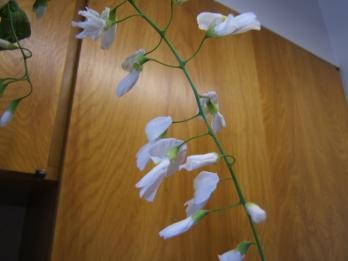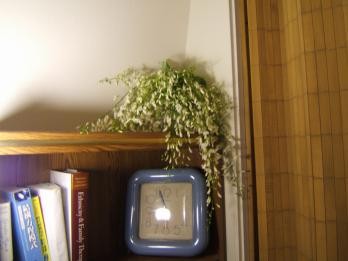
20060524
屋內飄蕩著費城裡頭湯姆漢克隨之翩然起舞的『La mamma morta』,屋外是一群隱身在樹枝頭的小鳥們跟著唱和……坐在書房裡,修改著最近畫好的畫,嘴角揚起一絲微笑,或許,這些鳥,需要著女高音的刺激,才會用力唱出牠們的天賦……喔,沒有啦!我還是流行通俗音樂的愛用者,雖然我非常偏食地只聽某些人唱的歌(不說你們也應該知道是誰)。古典音樂對我來說,仍然像是個深奧的殿堂,我不知道自己是不是有那樣的精力去搞清楚誰的曲風是怎樣,誰又是哪個年代的哪一國人,身邊有太多的事情在試圖分散我的注意力,所以,對古典音樂,我抱持的態度就是,不研究,純欣賞。儘管這樣的欣賞看熱鬧的成分居多,但是或許哪天熱鬧看久了,我就可以看出什麼門道了,對不對?
『La mamma morta』是朋友帶來給我的生日禮物其中的一首歌啦!別問我這是什麼文,在說什麼,我可是完全不知道。不過朋友可是對古典音樂頗有研究的喲!所以,當我這樣跟著看熱鬧看久了,被朋友強迫洗腦之後,雖然記憶力不是太管用,但我相信也會像認識星星一樣,記得幾個星座的辨認方式的呀!這又是一個要多交一些不同領域的朋友的例證之一,或許你也跟我一樣,身邊有著不少能人異士的說,只是你沒發現而已!
呵呵!對啦對啦!在提醒著知道我生日的人,我的生日又到了!等著你們的卡片啊!那些不知道我生日的人,無所謂啦!如果我沒有打算告訴你們,那其實也就是不覺得我可以有那樣的自信勞煩你們記得我的生日咩!所以別擔心!不會讓你們太緊張的!
隱約中,隨著微風的輕送,陣陣幽然的花香飄然入室……起身,查看著香味的來源。
隨著我在窗邊的探頭探腦,那些從層層綠葉之中發出的鳥囀更加雀躍,感覺上像是牠們的叫聲終於引起了我的注意一樣。就在我左顧右盼的時候,發現了掛在樹上一串串的白色小花,像是鈴鐺一樣無聲地隨風飄逸。而當它們隨著擺盪起它們柔軟的枝枒的時候,迎面而來的就是一陣陣的幽香。
找到了!帶著相機,走出室外,才發現,在我窗前的一抹靜白,其實是掛滿了整個樹梢。風一吹,所有的花鈴鐺和綠色的樹葉就跟著風輕拂上揚,那樣的輕拂,隱約像是輕盈的柔荑拂過我的下巴,也搔起了我淺淺的微笑。如果你剛好路過,就會看到我跟著一陣一陣輕柔擺盪的花鈴鐺上下左右地點頭微笑。
試圖照下我看到的景緻,不過,有時候,有些場景,需要的就是身歷其境,在那樣的光線下,那樣的溫度以及空氣中的水分含量與花開的程度,決定了心裡頭的騷動。照下來,寫下來或者像送我CD的朋友喜歡說的,『把那一刻看成永恆!』都無法去描述去替代那一刻的捻花微笑。
圖說:屋後搖曳著的香鈴鐺。還沒啦!我還沒搬家啦!只是準備要搬而已!

圖說:一枝花可以很優雅!
帶著些許的罪惡感偷偷摘了一串花,快速奔回家裡,將花插在水瓶中,心情因為小小的不道德而有著一些些的興奮。上網,看到師大老師在線上,丟了自己照到的相片給她,想要問問那到底是什麼樹,怎麼可以開出這樣的可愛小香花。
呵,了解我的朋友就會知道,當我發現人家懂的東西比我多的時候,我就會假設那人什麼都會,什麼都懂,所以,先問,而不是自己去查。為什麼會這樣呢?或許是因為我其實十分懶惰,自己去查很容易漫無頭緒,尤其是對於完全外行的領域,但是如果人家剛好知道,那樣的詢問就會給自己一個很有利的方向去深入了解,一如孔先生所說的,不恥下問。不問,就不容易以一個較有效率的方式去了解自己想要取得的知識咩!但是,真的要不恥喔!不過還好我臉皮厚,身邊的人也都超有耐心(可能是大部分在這裡唸書的朋友都知道自己以後得要授業解惑,這耐心如果不是與生俱來,至少也得要自己訓練自己啦),所以當我問他們的時候,很少得到拒絕。就算他們不知道,他們也會跟我分享他們認為的可能方向,讓我有更多的資訊去評估。
那些相片沒有丟成功,但是喜歡佈置家裡的師大老師聽說有香噴噴的美麗可愛小白花,馬上說她要過來。過來幹嘛?採花!
啊~~~~~~~~~這,那偷偷摸摸摘的一串花就讓我有著十分的罪惡感了,這師大老師竟然要堂而皇之地來當採花大盜?我問她,這是可以的嗎?學校的花可以這樣隨便亂摘的嗎?她說,在辦公室她看到了許多老師的桌上都有著許許多多的各式小花,那些都不是在花店買的,都是校園裡頭的植物。而且,這樣的採花,並不會傷害到植物本身,不摘這些花,花也會謝,她努力讓我相信,其實,無妨的。
好吧!呵呵!既然無妨,那就來吧!
於是,我們拉著樹枝枒,把花一串串地剪下來,發現,原來,採花其實是很,嗯,讓人心曠神怡的事情,呵呵!雖然我們還是不知道樹的名字,但是當兩個人興高采烈地分別捧著一大束花回家的時候,那名字,似乎一點都不重要呢!

圖說:一整叢也可以有她的熱鬧。
為了表示對這棵伴隨著我三年有餘,努力開開謝謝三個春秋才被我注意到原來有著這樣芬芳的香花的樹的敬意,我還是上網查了一下到底這是棵什麼樹。漫無頭緒地在網路上搜尋,是我剛開始做的事情。但是這樣的搜尋實在是太愚昧了,所以我把範圍縮小到校園裡頭,學校,應該要告訴我們到底在我們的周圍有著什麼樣的植物吧!
然後,比照過數十種的植物之後,找到了這棵樹的名字:Black Locust。如果要翻譯,叫做黑洋槐,但是因為花很香,所以師大老師說她要翻成香洋槐,比較貼切。呵,隨便!
有興趣的人請看我們學校植物系學生對這棵樹的介紹,就請允許我偷懶一下,暫時陶醉在花香裡吧!
Robinia pseudoacacia (Black Locust)
Identifying characteristics: The black locust is a fast-growing, deciduous tree to 50 feet with a straight trunk and an open, irregular crown. The leaves are once-pinnately compound and alternate, with 7 to 21 leaflets each 1.5 to 2 inches long. The leaflets are elliptic, with entire margins and a dark, bluish-green color, turning yellow-green and dropping early in the fall. The flowers are produced May to early June in dense racemes 4 to 8 inches long. The extremely fragrant flowers are 1 inch wide and creamy-white with a yellow blotch on the uppermost petals, remaining showy for 7 to 10 days. The fruit is a flattened, brown-black pod, tapering abruptly or rounded at the ends, containing 3 to 8 dark, spotted seeds. Pods may remain on the tree some time after maturing in October. The twigs are characteristically zig-zagged, with pairs of spines up to a half inch long at the nodes. The buds are apparently absent as they are embedded in the leaf scars. The terminal bud is absent. The reddish-brown bark is deeply furrowed into thick, interlacing, fibrous ridges.
Ecology:
Distribution: Native to the central Appalachian and Ozark mountains and southern Illinois, this tree now reproduces on its own throughout eastern North America and parts of the West. Naturalized or escaped from cultivation, it grows throughout most of Iowa along the edges of woods and in waste areas as thickets or groves.
Habitat: The black locust is extremely adaptable to a variety of soils and climates, although it prefers rich, moist, loamy soils of limestone origin. Because it fixes nitrogen in root nodules, this species can grow on sterile, sandy soils, helping to improve the condition of the soil. Tolerant of dry and saline conditions, the black locust has a wide-spreading root system and is often used for reclamation plantings of strip-mined or eroded land. The locust borer is the most damaging insect pest, generally killing trees before they reach mature size. The US Forest Service has worked to develop borer-resistant clones. Other pests and diseases of the black locust include canker, leaf spot, powdery mildew, locust leaf miner and scale.
Uses:
Wood: The wood is more resistant to decay and possesses a higher fuel value than any other broad-leafed tree native to temperate North America. The wood is hard, strong, heavy and shrinks and swells less than that of most other trees. It is used for fence posts, railroad ties, mine timbers, tree nails, insulator pins and fuel. The wood is widely sought for ship building and was exported to England in the last century for this purpose.
Wildlife: Bees make delicious honey from the nectar, and quail and squirrels eat the seeds. Black locust thickets are useful nesting sites for birds and form protective cover for wildlife.
Horticulture: This tree has long been used as an ornamental in Europe, but is seldom used in the US-perhaps because it provides poor shade and is attacked by many insect pests. It is a good tree for use in difficult conditions such as highway cutouts and strip-mined areas. Several cultivars have been developed: ’Aurea’, with young growth emerging yellow; ’Purple Robe’, with pink flowers and bronze new leaves; ’Pyramidalis’, a columnar, spineless cultivar.
文章定位:

